The minds behind "Shaun" hold forth for an informative half-hour on making (much) more with (much) less.
Add a CommentViewing: Blog Posts Tagged with: nick park, Most Recent at Top [Help]
Results 1 - 16 of 16
Blog: Cartoon Brew (Login to Add to MyJacketFlap)
JacketFlap tags: Interviews, Nick Park, Shaun the Sheep, Stop Motion, Spitting Image, Mark BUrton, Richard Starzak, Add a tag
Blog: Cartoon Brew (Login to Add to MyJacketFlap)
JacketFlap tags: Nick Park, aardman, Shaun the Sheep, Lionsgate, Inside Out, Illumination, GKids, Legends of Oz: Dorothy’s Return, Box Office Report, Minions, Mark BUrton, Richard Starzak, Strange Magic, Kahlil Gibran's The Prophet, Early Man, Dragon Ball Z: Resurrection F, Monster Hunt, FUNimation, Add a tag
The Aardman theatrical animation brand has become all but obsolete in the United States.
Add a CommentBlog: Cartoon Brew (Login to Add to MyJacketFlap)
JacketFlap tags: Oscars, Feature Film, Nick Park, Shaun the Sheep, Stop Motion, Wallace and Gromit, Academy Awards, Aardman Animations, A Close Shave, A Grand Day Out, A Matter of Loaf and Death, Dave Alex Riddett, The Wrong Trousers, Add a tag
Blog: Cartoon Brew (Login to Add to MyJacketFlap)
JacketFlap tags: Feature Film, Nick Park, Stop Motion, STUDIOCANAL, Early Man, Add a tag
Blog: Cartoon Brew (Login to Add to MyJacketFlap)
JacketFlap tags: Feature Film, Nick Park, aardman, Stop Motion, Aardman Animations, Peter Lord, David Sproxton, Olivier Courson, STUDIOCANAL, Early Man, Add a tag
The stop-motion director takes on his first feature film since 'Wallace & Gromit: The Curse of the Were-Rabbit'.
Add a CommentBlog: Cartoon Brew (Login to Add to MyJacketFlap)
JacketFlap tags: aardman, Aardman Animations, Peter Lord, David Sproxton, Early Man United, Feature Film, Nick Park, Add a tag
Blog: Cartoon Brew (Login to Add to MyJacketFlap)
JacketFlap tags: Nick Park, aardman, Aardman Animations, Peter Lord, David Sproxton, Early Man United, Feature Film, Add a tag
Blog: Cartoon Brew (Login to Add to MyJacketFlap)
JacketFlap tags: Nick Park, Shaun the Sheep, Aardman Animations, Chicken Run, The Pirates! Band of Misfits, Art Ludique, Wallace & Gromit, Events, Add a tag
The forty-three-year-old British animation studio is being honored with a major exhibit in Paris.
Add a CommentBlog: Cartoon Brew (Login to Add to MyJacketFlap)
JacketFlap tags: Oscars, Shaun Tan, John Lasseter, Nick Park, Pixar, Ward Kimball, John Weldon, John Canemaker, Chuck Jones, Ralph Eggleston, Richard Williams, Brandon Oldenburg, Kunio Kato, Bob Godfrey, Fred Quimby, Joe Barbera, Borge Ring, Bill Joyce, Torill Kove, John Kahrs, Michael Dudok de Wit, Academy of Motion Pictures Arts and Sciences, Bill Hanna, Ernie Pintoff, Will Vinton, Award Season Focus, Alexandre Espigares, Andrew Ruhemann, Bob Gardiner, Co Hoedeman, Dusan Vukotic, Edward Selzer, Eunice Macaulay, Francois Alaux, Herve de Crecy, Laurent Witz, Ludovic Houplain, Thomas Stellmach, Tyron Montgomery, Zbigniew Rybczynski', Add a tag
These rare videos document the presentation of the animated short Oscar from 1949 through 2013.
Add a CommentBlog: Cartoon Brew (Login to Add to MyJacketFlap)
JacketFlap tags: Ideas/Commentary, Nick Park, documentary, Audition, Ryan, Wonderland, Aardman Animations, Windy Day, Chris Landreth, John Hubley, Peter Lord, Creature Comforts, Faith Hubley, Waltz with Bashir, Animated Conversations, Audio production, Colin Thomas, Confessions of a Foyer Girl, David Sproxton, Down and Out, Hangovers, Jonathan Hodgson, Moonbird, Orly Yadin, Sylvie Bringas, The Trouble with Love and Sex, William Mather, Add a tag
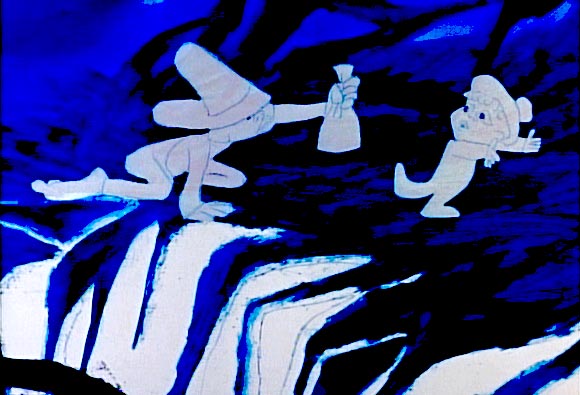
One of the better-known shorts made by John and Faith Hubley is Moonbird, from 1959. This film came about when the Hubleys made a secret recording of their two sons one night, playing a game in which they pretended to be hunting for the elusive Moonbird. The result was a soundtrack with a complete narrative, courtesy of the two children; the Hubleys and their studio then visualised the story to create the film.
It is surprising how well Moonbird works, considering that its story is simply two kids making things up as they go along. The personalities of the children come through very strongly and much of the recorded dialogue is inherently funny, as when the younger boy tries to recite “Hey Diddle Diddle” but has trouble remembering past the second word.

Moonbird was followed by the 1967 film Windy Day, based on the same concept but using the voices of the Hubleys’ two daughters. This short is much looser, with a transformative element as the two characters morph from one identity to another. Instead of a single narrative, the children deliver a free-flowing conversation which makes several twists: The two girls start by playing at being a knight and a princess, and later play at being animals; between these sessions they discuss birth, adulthood, marriage and death in the half-grasped manner of children.
Windy Day was shown at the 1968 Cambridge Animation Festival; amongst the people who saw it were producer Colin Thomas and animator William Mather.
“We were blown away by the use of raw unpolished sound with a highly controlled medium like animation”, said Mather in an interview I conducted with him in 2011. In 1975 the two put together a pilot film entitled Audition, based around a recording of Mather’s son talking to an organ player as he auditioned for the role of a choirboy.
The film is very different to Hubley’s shorts. Aside from a very brief sequence in which the boy imagines the organ turning into a monster, it does not take place in a world of childhood fantasy: Its aim is instead to recreate the conversation in more straightforward cartoon terms.
The Hubleys sought to create fantasy films when they made Moonbird and Windy Day, and turned to the taproot of so much fantasy: the imaginations of children. By contrast, Mather and Thomas created a film which was closer to documentary. It is worth noting that Thomas was a documentary filmmaker, and that BBC Bristol – the branch for which the two men made their pilot – has a strong documentary tradition.

The pilot led to Animated Conversations, a six-part series produced in the late-1970s by various directors. Mather contributed Hangovers, based on a recording of a barmaid and her customers, but the best-known shorts for this series were made by Aardman founders Peter Lord and David Sproxton.
The two Aardman shorts take quite different approaches. Down and Out is a literalistic portrayal of an elderly man being turned away from a hostel which – unlike Mather’s shorts – lacks any humor; its emphasis is instead on pathos. Confessions of a Foyer Girl, on the other hand, plays its material for laughs. A young cinema employee discussing the banal details of her day-to-day life is contrasted with the glamorous and exciting world of the movies.
Lord and Sproxton’s work on Animated Conversations prompted Channel 4 to commission its own series of animation based on natural dialogue, this time made entirely by Aardman: Late Edition, Sales Pitch, On Probation, Early Bird
and Palmy Day. As before, some of these went for wacky comedy, while others opted for melancholy tones.
Aardman’s subsequent work in this format includes Creature Comforts by Nick Park. As well as ranking as the single most famous example of the approach, it is one of the more playful in using its soundtrack. As the film is framed as a series of short interviews with various characters, Park was able to home in on the soundbites with the most comic potential. The earlier shorts built themselves around large chunks of undigested conversation, but the whole point of Creature Comforts is that the interviewees are quoted completely out of context.
Creature Comforts became an entire franchise, and in is now the key example of what is, today, a full-fledged genre of animation.
Sometimes the approach can serve a practical use. Animation students are often assigned the task of working to found soundtracks as lipsync exercises. “The Trouble with Love and Sex,” a 2011 episode of the BBC documentary series Wonderland, focused on people undergoing counselling; when it ran into the problem that these people were not comfortable being filmed, it simply used their voices, the visuals being animated by Jonathan Hodgson.
Meanwhile, other animators returned to the daring ethos of the Hubley shorts. Chris Landreth’s Ryan plays with intertextuality, using animation to illustrate interviews with and about animator Ryan Larkin. Sylvie Bringas and Orly Yadin’s’s Silence presents a child’s eye view of the Holocaust, alternating between harsh, woodblock-like sequences for the camp scenes and a softer, more childlike style for the postwar sequences.

There are three general approaches taken by these films. The first is a literalistic portrayal of the conversation, as with the melancholy Down and Out, the lighthearted Late Edition and the harrowing Waltz with Bashir (the last of these being the only feature-length animation of this type that I am aware of.) The second approach creates comedy by placing ordinary dialogue into an unusual situation, as with Creature Comforts.
Finally, the third approach uses animation to illustrate the more subjective aspects of the soundtrack, usually by attempting to recreate the mental state of the speaker. Examples include Silence, Ryan, Marjut Rimminen’s Some Protection, Paul Vester’s Abductees and Andy Glynne’s Animated Minds.
Jan Svankmajer once remarked that “animators tend to construct a closed world for themselves, like pigeon fanciers or rabbit breeders.” When an animated film uses unscripted audio, what we see is pure fantasy, but what we hear is an actual moment in time—the closed world of animation is suddenly opened up to stark reality.
IMAGES AND VIDEO IN THIS PIECE
1.) Still from Moonbird
2.) Still from Windy Day
3.) Audition
4.) Still from Confessions of a Foyer Girl
5.) Still from Creature Comforts
6.) Clip from “The Trouble with Love and Sex”
7.) Still from Waltz with Bashir
Blog: Cartoon Brew (Login to Add to MyJacketFlap)
JacketFlap tags: Nick Park, Studio Ghibli, Hayao Miyazaki, Aardman Animations, Toshio Suzuki, Princess Mononoke, Alexandra Rutter, Charlie Hoare, Joe Hisaishi, Kerrin Tatman, Polly Clare Boon, Whole Hog Theatre, Yoseph Hammad, Anime, Cartoon Culture, Add a tag
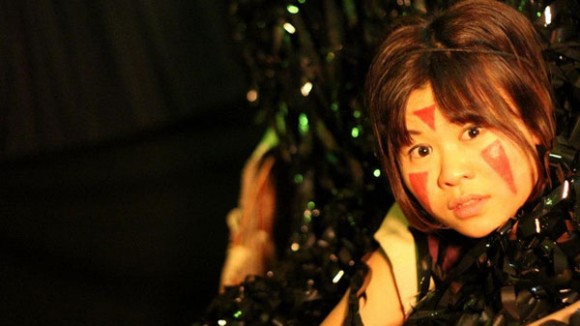
After a successful UK premiere and a short run in Tokyo, Whole Hog Theatre’s stage version of Hayao Miyazaki’s Princess Mononoke will return to London’s New Diorama Theatre next month due to “unprecedented demand.” The production is a collaboration between the British theatre troupe and Miyazaki’s Studio Ghibli and features large scale puppetry and a recreation of Joe Hisaishi’s original film score.
Miyazaki, who is known for refusing the re-versioning of his films into theatrical productions, approved the project after being presented with a video proposal from Whole Hog by way of Aardman’s Nick Park. As recalled by Studio Ghibli producer, Toshio Suzuki, he gave his consent “a couple of seconds” into viewing the presentation. Suzuki was equally impressed: “I wanted to watch a strange ‘Princess Mononoke’, he told the Wall Street Journal.
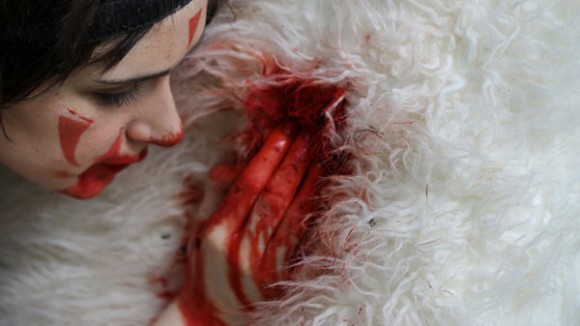
With puppets by Charlie Hoare and costumes by Yoseph Hammad, the show translates the film’s eco-friendly theme and inherent Asian aesthetic by use of reclaimed materials and a form of Japanese textile work called Boro, which involves the patch-working of rags into garments.
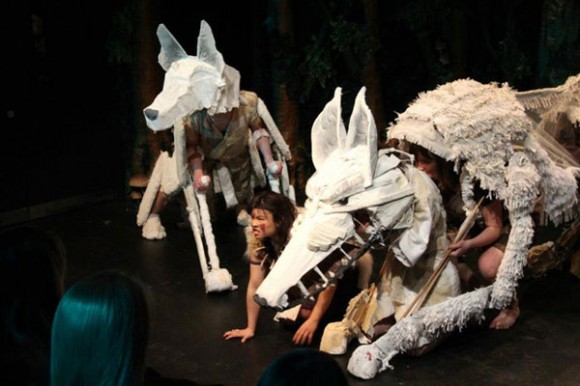
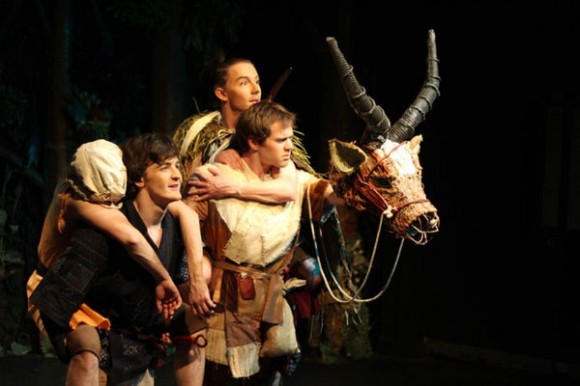
“Being a big Studio Ghibli and Miyazaki fan myself, I have no desire to alter the film’s narrative and atmosphere, or to add a ‘new spin’ on the story. I only want to re-tell it in a different form,” director Alexandra Rutter told Film-book.com. “However, whilst audiences can expect to see much of the film’s narrative happen onstage, they should also expect the techniques we use to tell the story to be quite different.” And her artistic objective has paid off as the production has been picking up positive word of mouth, selling out entire runs and was even featured as one of Lyn Gardner’s theater picks in The Guardian.
The second UK run of Whole Hog Theatre’s Princess Mononoke is scheduled for June 18th-29th at the New Diorama Theatre in London. The cast is led by Mei Mac as San/Princess Mononoke and Maximillian Troy Tyler as Prince Ashitaka. The production also features musical direction by Kerrin Tatman and design by Polly Clare Boon.
Add a CommentBlog: Cartoon Brew (Login to Add to MyJacketFlap)
JacketFlap tags: Eric Goldberg, Tim Miller, Jennifer Yuh Nelson, Pete Docter, Chris Wedge, Dean DeBlois, Directing for Animation, Directing for Animation: Everything You Didn't Learn in Art School, Focal Press, John Musker, Tony Bancroft, Books, Nick Park, Directing, Add a tag

Animation veteran Tony Bancroft (co-director of Mulan) has an interesting sound book in the works. It’s called Directing for Animation: Everything You Didn’t Learn in Art School.
The 246-page book will explore the directing process from start to finish, mixing personal stories and experiences with insights from top mainstream directors including Dean DeBlois, Pete Docter, Eric Goldberg, Tim Miller, John Musker, Jennifer Yuh Nelson, Nick Park and Chris Wedge. The book, which will be published in June, will retail for $34.95, and is currently available as a pre-order on Amazon for $21.68.
Blog: Cartoon Brew (Login to Add to MyJacketFlap)
JacketFlap tags: Ideas/Commentary, John Lasseter, Bob Clampett, Ward Kimball, Bill Plympton, Don Bluth, Hayao Miyazaki, Genndy Tartakovsky, Chuck Jones, Brad Bird, Frank Tashlin, Don Hertzfeldt, Friz Freleng, John Kricfalusi, Joe Barbera, Frederic Back, John Hubley, Joanna Quinn, Lotte Reiniger, Bill Hanna, Bruno Bozzetto, Emile Cohl, Walt Disney, Nick Park, Seth MacFarlane, Ralph Bakshi, Pen Ward, Richard Williams, Winsor McCay, Tex Avery, Pete Docter, Add a tag
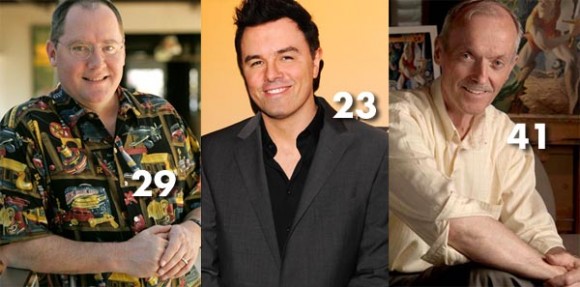
“Animation is a young man’s game,” Chuck Jones once said. There’s no question that animation is a labor-intensive art that requires mass quantities of energy and time. While it’s true that the majority of animation directors have directed a film by the age of 30, there are also a number of well known directors who started their careers later.
Directors like Pete Docter, John Kricfalusi and Bill Plympton didn’t begin directing films until they were in their 30s. Don Bluth, Winsor McCay and Frederic Back were late bloomers who embarked on directorial careers while in their 40s. Pioneering animator Emile Cohl didn’t make his first animated film, Fantasmagorie (1908), until he was 51 years old. Of course, that wasn’t just Cohl’s first film, but it is also considered by most historians to be the first true animated cartoon that anyone ever made.
Here is a cross-selection of 30 animation directors, past and present, and the age they were when their first professional film was released to the public.
- Don Hertzfeldt (19 years old)
Ah, L’Amour
Ah, L’Amour
The Ornament of the Lovestruck Heart
Tapum! The History of Weapons
Hook & Ladder Hokum
Little Red Riding Hood
Fiery Fireman
Larry & Steve
2 Stupid Dogs (TV)
Porky’s Badtime Story (or 23 if you count When’s Your Birthday)
Adventure Time (TV)
Girl’s Night Out
Gadmouse the Apprentice Good Fairy
The Night Watchman
The Little Island
Gold Diggers of ’49
Blue Monday
Puss Gets the Boot
Old Blackout Joe
Luxo Jr.
Amazing Stories: “Family Dog” (TV)
Rupan Sansei (TV)
A Grand Day Out
Mighty Mouse: The New Adventures (TV)
Monsters Inc.
Adventures in Music: Melody
Boomtown
How a Mosquito Operates
The Small One
Abracadabra
Fantasmagorie
Blog: Cartoon Brew (Login to Add to MyJacketFlap)
JacketFlap tags: Music Videos, Nick Park, Add a tag
Brad Bird isn’t the only Oscar winning animator releasing a live action film this month. Clay animator Nick Park (Wallace and Gromit) has directed this music video (below) for UK group Native and The Name. It does feature some pixilation and other techniques. Park explains the process in this behind-the-scenes video.
(Thanks, Tom Gasek)
Cartoon Brew: Leading the Animation Conversation |
Permalink |
No comment |
Post tags: Nick Park
Blog: Children's Illustration (Login to Add to MyJacketFlap)
JacketFlap tags: cute, animation, stop-motion animation, claymation, nick park, steve box, nick park, claymation, Add a tag
What is Art?
A Creature_Comforts film from Aardman Studios. Here's another where politicians debate the war in Iraq.
Blog: OUPblog (Login to Add to MyJacketFlap)
JacketFlap tags: Economics, africa, Business, Politics, Current Events, oxford, A-Featured, A-Editor's Picks, economy, Paul, Finance, oil, Collier, bottom, billion, g8, aid, diamonds, labour intensive, manufacturers, sustained, growth, rebellions, coups, Add a tag
Rebecca OUP-US
Today we are thrilled to have an original piece from Paul Collier the author of The Bottom Billion: Why the Poorest Countries Are Failing and What Can Be Done About It. Below, Collier a Professor of Economics and Director of the Center for the Study of African Economies at Oxford University, argues that the G8 did not go far enough in its efforts to assist Africa.
Since the 1960s around a billion citizens of the world have been diverging from the rest of us at an accelerating rate, a trend which will generate unmanageable social pressures. Most of these countries are in Africa, and so it is appropriate that the region should again have been on the G8 agenda during the recent summit in Germany. (more…)



What a fantastic video. I've immediately sent it around to all my artist friends. Thanks
How lovely!!!!
I think you'd like my blog, come visit!
www.caracarmina.blogspot.com
flying away now...